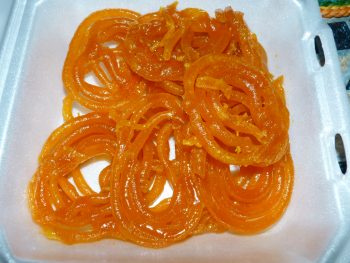Traditional Arabic Dessert: Zalabya زلابيا Posted by Hanan Ben Nafa on Jul 31, 2020 in Arabic Language, Culture, Vocabulary
Today, I would like to share with you the recipe of Zalabya/ Zalabyeh وصفة الزلابيا, a traditional Arabic dessert نوع من الحلويات العربية التقليدية that is known across the Arabic world, but specifically in North Africa where it’s also called Zlabya. It can be considered a type of sweet pastry نوع من المعجّنات حلوة المذاق that is usually eaten and sold in Ramadan and Eid but can also be found in small local shops المتاجر المحليّة الصغيرة during national and religious holidays العطلات الدينية والوطنية. You may or may not have heard of it as it’s not as popular as other Arabic sweets, such as Basboosa البسبوسة or Luqmat Al-Qadi لقمة القاضي. Below is a detailed recipe that you can follow, in addition to a video clip where the recipe was taken from.
Zalabya is not just found in the Arab world. It’s usually believed that it’s originally an Indian or Iranian sweet. It’s typically deep fried and is known for معروفة بـ its very sweets taste مذاقها الحلو كثيرًا and crunchy texture قوامها المُقرمش. It’s typically available in orange but I remember I saw some red/dark pink ones sold in some shops back home in Libya! It typically takes the shape of many circles inside each other and perhaps that’s the reason why it’s called Mshabbak مشبّك (in the Levant region) as the circles tend to be tangled or twisted round each other متشابكة.
So, let’s move on to the recipe now>>
(A) Syrup القطر/ الشيرة/الشراب
2 cups of sugar كوبين من السكر
1 cup of water كوب من الماء
food colouring gel سائل مُلوّن الأكل
A few drops of lemon juice بعض القطرات من عصير الليمون
(B) The Dough Ingredients مقادير العجين
1 cup of flour كوب من الطحين/الدقيق
¾ cup of water ثلاثة أرباع كوب من الماء
Pinch of salt رشة ملح
½ teaspoon of baking powder نصف ملعقة شاي/صغيرة من خميرة الحلويات
Steps الخطوات (A)
You first start preparing the syrup by mixing all the above ingredients (A) in a cooking pan.
نبدأ أولًا بتحضير الشراب بخلط كل المكونات (أ) في مقلاة
We stir until the sugar melts, then wait until the mixture boils for five minutes.
نحرك حتى يذوب السكر، ثم ننتظر حتى يغلي الخليط لمدة خمس دقائق
We move the pan off the stove then we add the food colouring.
نبعد المقلاة عن النار، ثم نضيف ملوّن الأكل
We leave the syrup to cool down a bit and use it warm.
نترك الشراب ليبرد قليلًا، ونستعمله دافئًا
Steps الخطوات (B)
We add the flour and salt.
نضيف الطحين والملح
We pour the water gradually and mix everything for 5 minutes.
ثم نصب الماء تدريجيا، ونخلط كل شيء لمدة خمس دقائق
Then, we finally add the baking powder.
ثم أخيرًا، نضيف خميرة الحلويات
The texture of the dough should be liquid and a bit thick.
يجب أن يكون قوام العجين سائل وغليظ بعض الشيء
Final Stage الخطوة الأخيرة
Use a funnel to pour the mixture into a bottle that has a small hole on top.
استخدم قمعًا لصبّ الخليط في قارورة بها فتحة صغيرة من الأعلى
Heat the oil, then set the stove temperature to medium.
سخّن الزيت ثم نضع النار على درجة حرارة متوسطة
We start pouring the dough into the oil, in a circular way.
نبدأ بصب العجينة على الزيت بشكل دائري
After the dough is done from one side, we flip it, so the other side is done too.
بعد استواء العجينة من أحد الجوانب، نقلبها لكي يستوي الجانب الآخر أيضًا
And finally, we remove the zalabya from the oil and transfer it into the syrup bowl directly.
وأخيرًا، نُخرج العجينة من الزيت، وننقلها مباشرةً إلى وعاء الشراب
We put it aside to serve it.
ثم نضعها جانبًا للتقديم
🙂 هنيئًا مريئًا
Bon appetite / Enjoy

Build vocabulary, practice pronunciation, and more with Transparent Language Online. Available anytime, anywhere, on any device.




